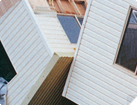Site Analysis
Understanding all the features of a site, using and protecting the best, and minimising the impact of the worst.
Wind
Wind direction, speed and frequency will influence the building design including bracing requirements, roof and wall cladding selection, weathertightness detailing, building entry locations, window size and placement and provision of shelter for outdoor spaces.
On this page:
- designing for wind
- wind regions and zones
- specific design
- gathering information about local wind conditions.
Designing for wind
Generally, designing for wind will require providing shelter but in hot or humid climates, the building design may deliberately incorporate features or shapes to provide cooling breezes for a passive cooling effect.
In remote locations, wind speed and frequency may also be a factor in selecting wind as a power generation source.
Make your assessment of wind effects early in the design process. This should include the speed (average and peak) and direction of wind, and how it affects the site at different times of year.
Factors influencing wind speed on a specific site are shown in the following table.
| Regional and site features | Comments |
| General wind speeds in the region | Source from: • NIWA • Metservice |
| Level of site exposure | Determine from on-site observation |
| Terrain | Wind speed will: • increase as it passes over or between hills • slow down as it passes over rougher terrain (drag effect) • accelerate over open and flat expanses of land or water |
| Large expanse of water nearby, e.g. sea or a lake | During the day, solar gain will heat the land mass, resulting in an increase in temperature relative to an adjacent large body of water. As air warmed by the land rises, cooler air from over the water will replace the rising air, resulting in the generation of afternoon, on-shore breezes |
| Adjacent buildings/ vegetation | Wind speed: • is lower when a site is surrounded by taller buildings • will increase where it funnels around or between buildings • is slowed by trees and vegetation |
| Building height | The higher the building, the more exposed it will be to higher winds, particularly where the building is taller than adjacent buildings or vegetation. |
The prevailing wind direction must be considered in relation to the design of a building, in particular, for locations of doors and opening windows, and provision of shelter for outdoor areas. Other aspects of wind to consider include:
- the direction of the strongest wind
- the direction of the coldest wind
- humid/dry winds
- wind that comes off the sea (salt spray issues)
- the wind direction that brings most of the rain.
Wind regions and zones
NZS 3604 Timber framed buildings requires that buildings are designed to withstand the winds that they are likely to be subjected to. Bracing requirements must be calculated separately for both wind and earthquake loadings; the bracing must be designed for the greater of the two loads. The amount of bracing required to resist the lateral wind loads on the building under NZS 3604 is based on the design wind speed.
NZS 3604 divides New Zealand into two wind regions (A and W) and several lee zone areas – these are areas where the landforms create localised wind acceleration resulting in higher wind speeds than the rest of the region.
It also classifies wind zones into categories, set out in the following table, according to maximum ultimate limit state speeds.
Wind zone classifications (from NZS 3604 Timber framed buildings)
| Classification | Maximum ultimate limit state speed |
| Low | Below 32 m/s |
| Medium | 37 m/s |
| High | 44 m/s |
| Very high | 50 m/s |
| Extra high | 55 m/s |
| Specific design (SD) | Over 55 m/s |
Table 5.1 in NZS 3604 provides steps to determine wind zone. From Table 5.1, determination of the wind zone for a particular site requires the following steps:
- Determine the wind region.
- Determine whether in a lee zone.
- Determine ground roughness.
- Determine site exposure.
- Determine topographic class.
In practice, there are several different ways to establish the wind zone for a specific site. They are, with the most precise method at the top:
- Calculations made specifically for a site following AS/NZS 1170.2:2021 Structural design actions, Part 2: Wind actions
- Calculations made specifically for a site following NZS 3604:2011 Timber-framed buildings
- Council wind maps (if based on AS/NZS 1170.2:2021 or NZS 3604:2011)
- BRANZ Maps. BRANZ Maps is an experimental tool that can assist in determining a wind zone – it is not yet sufficiently precise to give a definitive wind zone for a specific site.
Specific design
The wind zones defined in NZS 3604 are based on a number of simplifying assumptions, such as wind direction, general topography and shelter. In some situations, the wind zone classifications may under- or over-estimate the site wind speed. In such cases, employing an engineer to assess the site conditions may be a more cost-effective design option. It will be required where the wind speed is over 55 m/sec.
Gathering information about local wind conditions
A site visit may give some indication of wind speed and predominant or strongest wind direction. Observe vegetation and features on the site. Talk to neighbours and observe how neighbouring properties deal with the effects of wind. Indicators of high wind speeds include:
- a general lack of developed planting
- stunted tree and shrub growth
- wind break fences on adjacent properties
- wind shaping of existing planting.
The local council should be able to give advice on the wind zone of any property within its boundaries. Some local authorities have this information online. A land information memorandum (LIM) may contain information about the property’s wind zone.
The National Institute of Water and Atmospheric Research (NIWA) provides climate station data for its 30 climate stations throughout New Zealand, which includes wind speeds, number of gale days per month, and wind roses (diagrammatic representation of historical wind patterns).
Updated: 25 February 2024


